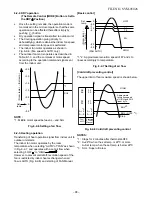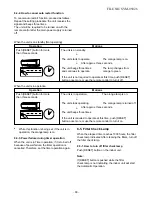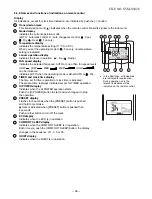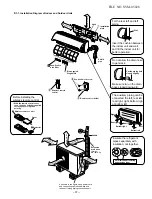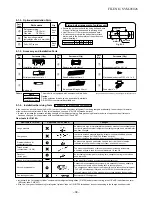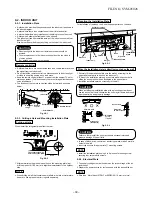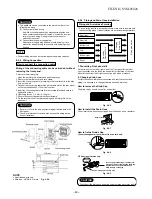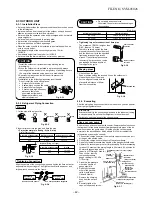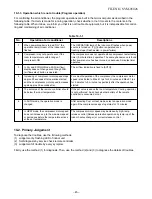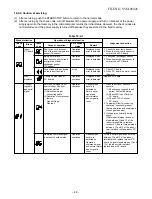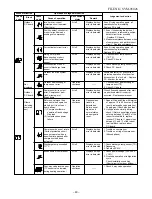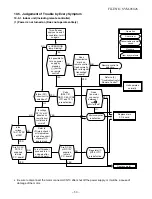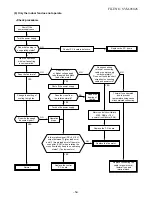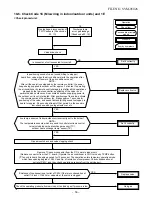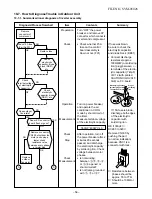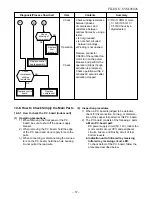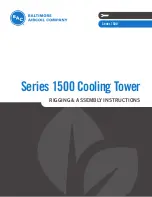
FILE NO. SVM-05026
– 42 –
9.3 OUTDOOR UNIT
9-3-1. Installation Place
•
A place which provides the spaces around the outdoor unit as shown
in the left diagram.
•
A place which can bear the weight of the outdoor unit and does not
allow an increase in noise level and vibration.
•
A place where the operation noise and discharged air do not disturb
users neighbors.
•
A place which is not exposed to a strong wind.
•
A place free of a leakage of combustible gases.
•
A place which does not block a passage.
•
When the outdoor unit is to be installed in an elevated position, be
sure to secure its feet.
•
An allowable length of the connecting pipe is up 10m for
10UKV-E.
•
An allowable height level is up to 8m for 10UKV-E.
•
A place where the drain water does not raise any problem.
Strong
wind
Flaring
1. Cut the pipe with a pipe cutter.
Fig. 9-3-2
2. Insert a flare nut into the pipe, and flare the pipe.
•
Projection margin in flaring : A (Unit : mm)
Rigid (Clutch type)
9-3-2 Refrigerant Piping Connection
Die
Pipe
90
°
Roughness
Warp
Obliquity
A
Imperial (Wing nut type)
Outer dia. of copper pipe
R-410A tool used
Conventional tool used
6.35
0 to 0.5
1.0 to 1.5
9.52
0 to 0.5
1.0 to 1.5
Outer dia. of copper pipe
R-410A
6.35
1.5 to 2.0
9.52
1.5 to 2.0
CAUTION
•
Do not apply an excess force.
Otherwise, the nut may crack depending on
the conditions.
(Unit : N·m)
Outer dia. of copper pipe
Tightening torque
Ø6.35 mm
14 to 18 (1.4 to 1.8 kgf·m)
Ø9.52 mm
33 to 42 (3.3 to 4.2 kgf·m)
Flare nut
Half union
Use a wrench to secure.
Use a torque wrench to tighten.
Externally
threaded side
Internally
threaded side
Tightening Connection
Align the centers of the connecting pipes and tighten the flare nut as far
as possible with your fingers. Then tighten the nut with a spanner and
torque wrench as shown in the figure.
•
Tightening torque for connection of flare pipe
The pressure of R-410A is higher than
R-22. (Approx. 1.6 times)
Therefore securely tighten the flare
pipes which connect the outdoor unit
and the indoor unit with the specified
tightening torque using a torque
wrench. If each flare pipe connects
incoorectly, it may cause not only a
gas leakage but also a trouble or
the refrigeration cycle.
Shaping pipes
1. How to shape the pipes
Shape the pipes along the incused line on the outdoor unit.
2. How to fit position of the pipes
Put the edges of the pipes to the
place with a distance of 85mm
from the incused line.
Flare at indoor
unit side
Flare at outdoor
unit side
CAUTION
1. Install the outdoor unit without anything blocking the air
discharging.
2. When the outdoor unit is installed in a place exposed always
to strong wind like a coast or on a high story of a building, secure
the normal fan operation using a duct or a wind shield.
3. Specially in windy areas, install the unit to prevent the
admission of wind.
4. Installation in the following places may result trouble.
Do not install the unit in such places.
•
A place full of machine oil.
•
A saline-place such as the coast.
•
A place full of sulfide gas.
•
A place where high-frequency
waves are likely to be
generated as from audio
equipment, welders, and
medical equipment.
Fig. 9-3-1
Fig. 9-3-3
Fig. 9-3-4
Fig. 9-3-5
Use a vacuum pump
Be sure to use a vacuum pump with counter-flow prevention function so
that inside oil of the pump does not flow backward into pipes of the air
conditioner when the pump stops. (If inside oil of the vacuum pump
enters into the air conditioner which adopts R-410A, a trouble of the
refrigeration cycle may be caused.)
1. Connect the charge hose from the manifold valve to the service port
of the gas side packed valve.
2. Connect the charge hose to the port of the vacuum pump.
3. Open fully the low pressure side handle of the gauge manifold valve.
4. Operate the vacuum pump to start for evacuating. Perform evacuating
for about 15 minutes if the piping length is 20 meters. (15 minutes for
20 meters) (assuming a pump
capacity of 27 liters per minute.)
Then confirm that the
compound pressure
gauge reading is –101 kPa
(–76 cmHg).
5. Close the low pressure
side valve handle of
gauge manifold.
6. Open fully the valve
stem of the packed
valves (both side of
Gas and Liquid).
7. Remove the charging
hose from the service
port.
8. Securely tighten the
caps on the packed valves.
9-3-3. Evacuating
After the piping has been connected to the indoor unit, you can perform
the air purge together at once.
AIR PURGE
Evacuate the air in the connecting pipes and in the indoor unit using
a vacuum pump. Do not use the refrigerant in the outdoor unit.
For details, see the manual of the vacuum pump.
Incused line
85 mm
Fig. 9-3-6
Packed valve at liquid side
Pressure gauge
Manifold valve
-101kPa
(-76cmHg)
Handle Lo
Connecting
pipe
Packed valve at gas side
Compound pressure
gauge
Vacuum pump
adapter for
counter-flow
prevention
(For R-410A only)
Vacuum
pump
Handle Hi
(Keep full closed)
Charge hose
(For R-410A only)
Charge hose
(For R-410A only)
Service port
(Valve core (Setting pin))
Fig. 9-3-7
Содержание RAS-10NAV-A
Страница 17: ...FILE NO SVM 05026 16 4 2 Outdoor Unit ...
Страница 77: ...FILE NO SVM 02007 78 TOSHIBA CARRIER CORPORATION ...

